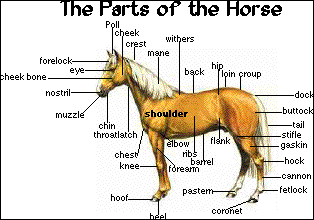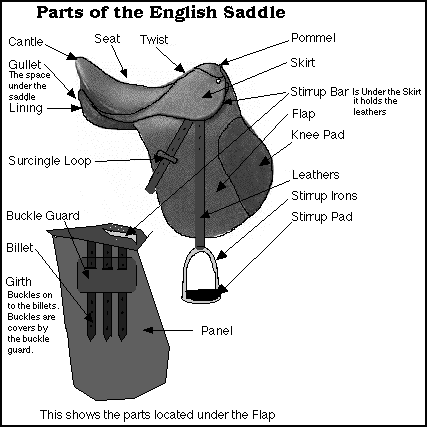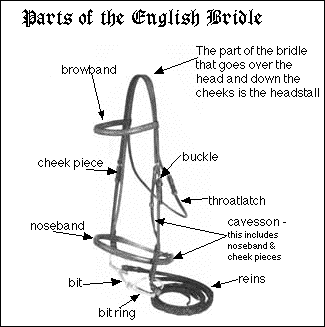The points of the horse

Here are the basic points of the horse.
Breeds

Breeds and breeding can seem a difficult and technical subject which is best left to the experts. However, anyone interested in horses and ponies should have some knowledge of breeds.
There are more than 200 recognised breeds throughout the world. Many have their own Breed Societies, whick keep registers or stud books listing certain horses or ponies. These animals have been carefully and selectively bred, and show clearly defined characteristics of the breed, includng conformation, colour, height and action. As well as the established breeds, there are a number of horses known as ‘types’. Hunters, cobs, hacks, riding and polo ponies are all types of horse or pony.
From Eohippus to the Thoroughbred
The earlist ancestor of the horse was the Eohippus, an animal about the size of a fox with four toes. Several millions of years later, the horse we recognize today, called Equus, fist appeared in North America.

The Arab, about which much is known, is perhaps the oldest and purest of the breeds we know today. Carvings of this horse dating from about 1500BC have been found in Egypt and the Middle East. More recently, the Adulusion breed from Spain played a large part in the development of breeds and breeding.
During the eighteenth century the famous English Thoroughbred was established by crossing selected home-bred mares with the three Arab stallions – the Darley Arabian, the Godolphin Arabian and the Byerly Turk. Today the Thoroughbred has been crossed with many other breeds.
Colours

The principal colours of horses and ponies are black, brown, bay, chestnut and grey. There is no ‘white’ horse – an animal with a very light coat is described as a ligh grey. Other colours and mixtures of colours include dun, roan, piebald and skewbald. Colour combinations outside these are known as ‘odd-coloured’.
During the first year of a horse’s life, the body colour (pigmentation) begins to change, and its so called ‘true’ colour will not emerge until late in tits second year. It is interesting that the coat of many black foalswill grow out to become grey. If doubt arises over a horse’s true colour (sometimes required for a society o for use on a horse passport), reference is made to the colour of the hair in the muzzle, tips of the ears, the mane and tail.
Markings

Although horses and ponies are described bythe colour of their coats, th markings are also identifying features.. Markings appear principally on the body, legs and head. Where no markings are to be seen, the horse is known as ‘whole-coloured’.

At times, markings can be easily confused with colours. For example, a ‘spotted’ horse, such as an Appaloosa, has spots mainly across its quarters, although they occur all over the body and limbs. Some people wrongly call all spotted horses Appaloosas; it is, however, a recognised breed, as is the Knabstrup from Denmark.
A ‘flecked’ horse or pony is marked with small collections of white-coloured hairs appearing irregularly over the body. The zebra-marked horse is very much as its name suggests, the marks showing on the shoulders, back, quarters and legs.
Another colour/marking combination is ound on the Pinto, a breed from the United States. The word pinto comes from the Spanish word, pintado, meaning painted – a true description of a most beauiful breed.
Any horse or pony with a ‘dorsal’ stripe will show a continuous line runnning along the spine from mane to tail.
Saddles

The diagram above shows the points of the saddle.
Bridles

The diagram above shows the points of the bridle.
I hope that you have either learnt some new knowledge about the horse, extended your knowledge and have begun to understand the horse itself.






